7 Favourite Irish Ancestry Moments from Series 4 of the Letter from Ireland Show (#410)
As we reach the end of series 4 of the Letter from Ireland Podcast show, we'd thought we would share just 7 of our favourite moments. It was a tough choice and we hope you enjoy them!
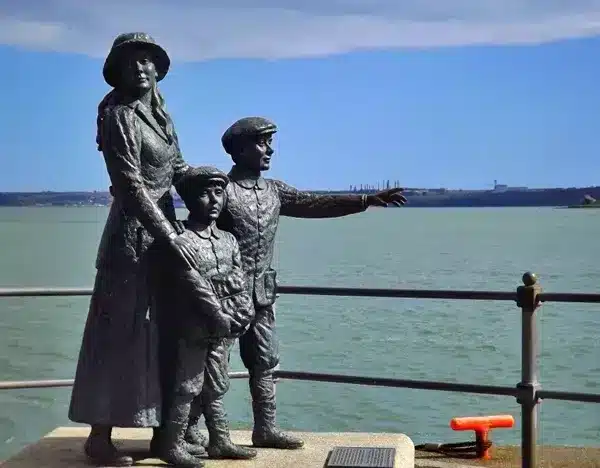
You can listen to the show on your computer/smartphone by clicking on the play button above (the triangle with the circle around it). You can also download the show onto your computer by clicking on the download symbol. Enjoy!
Episode Summary:
Welcome to Season 4, Episode 10 of the Letter from Ireland Show.
In this episode of the Letter from Ireland Show, we share some of our favourite moments from this series of the podcast. We have people for you to meet, places to visit and lots of unique insights that have made this series of the podcast so special to us. See what you think!
The Letter from Ireland Show is a weekly podcast that goes out each Thursday from our cottage in County Cork. Tune in to this episode – and dive straight in to a bit of Irish caint, ceóil agus craic (conversation, music and craic!).
Transcription:
Carina: For today’s show, we picked seven highlights from the series. Remember, we started off in Tasmania, then we went to the northeast of the US, visiting Ellis Island, New York, on to Boston. Nearer home, we visited Wales in the UK, then Dublin, and finally we were back home to Cork, Ireland.
Along the way, we’ve shared your stories of searching for your Irish heritage and then we took a deeper look into the research methods and shared tools to help break down those Irish ancestry brick walls.Mike chatted about his Research Wheel in the Green Room, which was also a wonderful all-round tool to help you get to grips with the complexity of the Irish ancestry records.
Then Jayne McGarvey, our Irish-based genealogist from Northern Ireland, showed how to progress along to becoming a competent Irish family history researcher.
And while we were in Boston, we took the opportunity to chat with Pam Holland, who is now our US-based genealogist in the Green Room, and she gave some very valuable pointers on finding those essential US records before looking for your ancestors back in Ireland.
So would you like to hear more? Because if any of those interviews caught your attention, do stay listening as we’re going to capture the highlights of the series in today’s Letter from Ireland Show.Now, before we start into today’s show, remember you can see all the links we mentioned in the show notes at aletterfromireland.com/410. So let’s kick off.
From County Sligo to Tasmania.
We Irish love a good story, so why don’t we begin the show today with some stories from our members mentioned throughout Series Four. Here is Doug in Tasmania from Episode 401 and Doug’s Irish ancestors, the Barretts moved from Sligo in the northwest of Ireland to Tasmania back in the early 1800s.
We chatted with Doug overlooking the beautiful Tamar River outside Launceston in northern Tasmania. We were standing on the old farm land where Doug’s great-grandfather, James Barrett, from Sligo, first farmed. Here he tells about his enterprising Barrett family and how they fared in Tasmania. We’re here on the Irish-Australian ancestry trail and today we’re meeting Doug Barrett. Doug, you’ve driven us out from Launceston in Tasmania to this wonderful farm here. So can you tell us why you brought us to this farm?
Doug Barrett: Well, this was the place where my great-grandfather settled on the eastern side of the Tamar River in the 1830s. And his two brothers came out from Ireland.
Carina: Where in Ireland did they come from?
Doug Barrett: Sligo.
Carina: And what did they do when they were in Ireland? What was their work there?
Doug Barrett: That’s a bit of a mystery at the moment. I’m not really certain. There’s rumours that they worked for the, the Sligo Harbour Trust. And there’s also rumours that they were in the Sligo militia.
Carina: Aha.
Doug Barrett: But nothing’s been proven yet.
Carina: So James Barrett came out here, and William, and James settled on this land here.
Doug Barrett: They settled on this land and-
Carina: How big a farm was that at the time?
Doug Barrett: It’s a thousand acres.
Carina: Wow! Okay.
Doug Barrett: And he slowly cleared it by hand. He had a contract with the government to supply firewood and unfortunately things got bad for him and he ended up dying of cancer.
Carina: Were there other things he got up to while he was here?
Doug Barrett: Well, he was involved in the liberation of escaped Irish political prisoners and that was Thomas Maher.
Carina: Okay.
Doug Barrett: And John Mitchell. And that’s only two and there’s books written about both of those two convicts.
Carina: And you were saying earlier to us that he rowed them up to the …
Doug Barrett: He rowed them from up the Tamar, right down and out to Waterhouse Island, which is about 20 miles off the Tamar River, so it was a fair journey and most of it was done by …
Carina: Hands. Was it rowing? Just rowing?
Doug Barrett: Most of it was done in the middle of the night.
Carina: Oh, my goodness. So he navigated the river in the middle of the night and got the people out to that island where the boats then took them to America, is what you were saying?
Doug Barrett: Yes, yes. Some of them had to stay there for 10 days or a fortnight until the boat came past to pick them up.
Carina: Wow! I see. And he himself then got ill, I think you were saying, when he wasn’t that old and he died from cancer?
Doug Barrett: He died from cancer and then the family had to move off this property.
Carina: This wonderful property they had to let go.
Doug Barrett: Yes. Yes. But they moved over to the Furneaux Group. The government offered cheap land that-
Carina: The Furneaux Group is a group of islands, isn’t it? Yeah.
Doug Barrett: Yes. It is. Flinders island is the largest island. There’s 52 islands in the Group and the French were snooping around and the government wanted all the islands inhabited.
Carina: Populated? yeah.
Doug Barrett: And so that the French would be warned off.
Carina: Uh-huh. So his wife and son moved onto one of those islands then.
Doug Barrett: Onto Long Island, and established the first shop and post office in the Furneaux Group.
Carina: Oh. Enterprising people so!
Doug Barrett: As well, he had a trading ketch, which he operated from the Furneaux Group to Launceston.
Carina: This was his son. Yeah, yeah.
Doug Barrett: Yes, it was.
Carina: Very good. And you discovered something recently that there was a grave there.
Doug Barrett: Yes, there’s a grave on Waterhouse Island that belongs to James Barrett, my great-grandfather. I’ve been searching for that grave for years and I stumbled across it by chance only last week.
Carina: And you yourself live now or lived out on those islands as well?
Doug Barrett: I lived there until last year, this time last year, and I moved to the tribe in Tassie.
The Cascades Female Factory, Tasmania.
Carina: Doug’s family, of course, traveled freely and by choice to Tasmania to begin a new life, but others were not so fortunate. Here is the story of the women convicts who are the mothers of modern Tasmania.
I’m standing in the Female Cascades Factory, a factory really being a work house, a penitentiary, prison for females in Hobart, just outside Hobart, under Mount Wellington. This location here for the factory was originally a rum distillery and was bought by the government in 1826 as somewhere to house women convicts.
The women convicts were marched here in the middle of the night so as not to attract any attention from the locals or the sailors down at the port in Hobart. They came here and spent either as a first-, second- or third-class prisoner their years here. They could be here for 7, 14, 21 or life depending on what their crime was, for a crime as little as stealing an egg. The guy told us there, there was a little girl picked up, she was 11 years, and sent out here for stealing an egg.
So it’s been almost traumatic really for us, just even looking around the yards as they were called. And this is the women’s clothes just behind me here, which would have been really heavy cotton. Their heads were shaved when they came here. They were put into these heavy, cotton outfits and marked with C, for convict, and really it was very, very inhuman. We’re here now on the final yard that we’ve been brought ito. This is the nursery and as many as 70, 75% of the children died here. Of course, they were never allowed here after the age of three and then they were moved on to the orphanage. So it’s quite shocking. But I suppose one hopeful thing about it was at the end, I remember reading, that between one of five to one of seven Australians today are descended from these women. Who were, as our guide said, more sinned against than sinners.
From Queenstown/Cobh in County Cork.
Carina: Here is Jack Walsh, manager of the Cobh Heritage Museum in Cobh, County Cork. And of course 3 million of our ancestors left Ireland from Cobh. This is Episode 407. Have a listen to what Jack has to say. So we’ve stepped into Cobh into the old railway station, which is now a Heritage Centre and I’m here chatting with Jack Walsh. Jack, you’re the manager here of the Centre. Can you tell us a little bit about your own background and where you started off with all these transatlantic journeys, maybe in your own life?
Jack Walsh: My first memory would be when I was growing up as a little boy, my family had a pub and a place called The Stall in County Kerry and my mother was the agent for the Cunard Shipping line. So she sold tickets to any of the local young guys or young girls who were contemplating emigrating, especially to the US.
I often watched those guys sitting in the bar with their pints, filling in all the documentation. And possibly a week later those guys were gone off to New York, Boston, Chicago, wherever. In lots of cases they were probably never seen again.
That was in the early 1960s. But I suppose if you’d gone back a hundred years to the 1850s, 1860s, anybody contemplating emigrating to the US at that stage, they definitely didn’t come back. They had a tougher journey because nowadays you have trains, cars, buses. In those days you had donkeys, donkey and carts and maybe rowing boats.
Carina: So how would a person have come down here to Cobh and got on the boat? What would their journey have been like?
Jack Walsh: Well, from the 1860s onwards, they could have caught the train in some place like Killarney and gone to Cork. Then got the train from Cork to Cobh and then directly onto the ships.But a lot of them, depending on when they arrived and when their ship was sailing, would have had to have got lodging somewhere in Cobh.
The lodging houses were famous because you didn’t know what you were going to find in there. Right? And the bean an tí’s, as we call them here, the lodging house ladies, had lots of little different ways of getting business and saving a few pound. For example-
Carina: I’m sure you must tell me about one of those.
Jack Walsh: If for example, you had booked for your bed and breakfast, maybe six o’clock in the morning before breakfast is being served, somebody was shouting outside the door, “Quickly, everybody. The boat is here,” right? So everybody would leave the bed and breakfast and no breakfast served. But the bean an tí has already been paid for it. So little tricks like that.
But the lodging houses in Cobh were famous at that time because people were coming from all over the country. A lot of them were young, they didn’t know their way around. They were sort of rural people from the west of Ireland, for example. Coming into a large town would be strange, to a town they’d never been in, looking for somewhere to stay ,they would have to trust the people. They were very trusting. That didn’t always leave with the money they arrived with. Let’s put it that way.
Carina: And that was- that was the start of their journey?
Jack Walsh: Yeah. From here then, you know, you get on a ship in the 1860s, 1870s, it might’ve been two or three weeks sailing across the Atlantic in all sorts of weather. So a lot of them were fairly sick when they got to the other side.
Carina: Thanks very much, Jack, for filling us in on what it was like. We’re going to have a look around the Heritage Centre now and see the different parts there. I know you will have some stories about the families that came through so we’ll chat some more. Thanks very much.
Jack Walsh: No problem at all.
St. Patrick’s Day on Ellis Island.
Carina: And we had stories from the US too. On Ellis Island, Episode 407, Green Room members generously shared the stories handed down in their families about those who traveled through Ellis Island and the keepsakes they brought with them from Ireland. Here is Deirdre Maguire.
Carina: Deirdre, you’ve joined us today on the tour of Ellis Island because your family, the Maguires …
Deirdre Maguire: They came over here. They were living in Blacklion, my grandfather.
Carina: So Blacklion is between Cavan-
Deirdre Maguire: Is between Cavan and Fermanagh, which is like the seat of all the Maguires and I’ve actually been to the Maguire castle up in Enniskillen and they have a fascinating folk museum there as well. So I’ve come full circle here.
Carina: And when your Maguire came here, who was that? What was the name of that Maguire?
Deirdre Maguire: That was John Maguire.
Carina: And he came here through Ellis Island?
Deirdre Maguire: He came through Ellis Island? Yes, he did.
Carina: What year would that have been?
Deirdre Maguire: In 1904. He was 26 years old. And then he met my grandmother here who was also from Cavan. She was a Brady and they got married and had two children and …
Carina: Did they stay around this area here at Ellis Island?
Deirdre Maguire: They stayed in Manhattan. They were up near St. John The Divine, is where they raised a family and …
Carina: And I know we were looking at the cases in the hall there when we came in and that you mentioned the luggage cases.
Deirdre Maguire: Yes.
Carina: And you mentioned the story you had about that. Would you like to share that with us?
Deirdre Maguire: Well, yeah. My grandmother had a trunk that she brought with her. I still have it up in my attic. She brought it through here and it had some of her clothing and her sister’s clothing and she had some cast iron pots and pans, that was still in the family when I was a child.
Carina: Yeah. That’s what we’ve noticed today that people all have little memories of things that came through and that even though it’s down two generations, they still have those, whether it’s shoes or clothes or pots.
Deirdre Maguire: And there was a Belleek teapot, which I guess was a treasure at that time.
Carina: Oh, it still is!
Deirdre Maguire:.. that smashed into a hundred pieces at some point. It’s a shame. I don’t-
Carina: Well, we call those “smithereens”.
Deirdre Maguire: Smithereens!
Carina: And Fermanagh?
Mike: The Belleek?
Deirdre Maguire: Yes, the Belleek from Fermanagh that, now … I assume she got it there and brought it over with her. It was very, very old and just glued together when I was a child. Again, I don’t know what’s happened to it.
Carina: Thanks, Deirdre. Thanks for sharing your story with us.
And as we left Ellis Island, New York, here is Jane Mackesy with her memories as she shares them with us about her Irish ancestor on Episode 407.
Jane Mackesy: Hi, I’m Jane. I’m from Corny, New Jersey, but I grew up right here in Jersey City where the Liberty State Park is, where the ferry takes off to Ellis island. This was where, our ancestors or the immigrants would come through the doors over there and come over here and take trains to wherever their final destination might be.
It might be just in New Jersey. It might be Chicago. It might be somewhere out in the Midwest. At least this is what I’ve been told. I’m not exactly sure.
Carina: Just looking at it today, you can see still, the platform’s exactly where the trains would have pulled in and you can almost imagine it crowded with people, can’t you?
Jane Mackesy: Yes, exactly. Exactly.
Carina: Yeah.
Jane Mackesy: To think that my grandfather came through this place here. I can’t …
Carina: That was in …
Jane Mackesy: 1905.
Carina: In 1905 and what was his name, Jane?
Jane Mackesy: John Feeney.
Carina: John Feeney.
Jane Mackesy: From Galway.
90,000 Questions and Answers in The Green Room.
Carina: Many listeners to the show and readers of the Letter join the Green Room to discover more about their Irish ancestors. From Episode 405, called Five Years and 90,000 Questions, Mike explains how it all began.
Mike: Yeah, isn’t it amazing? Five-plus years at this stage. I mean we were just talking about this the other day, Carina, and there’s been, how would I put it?
I suppose if you’re the sort of person who just writes a book or something and fires it out there and meets the fans every now and again, that’s one sort of operation. But in our case we found very, very quickly that as soon as you actually put something out there, a hundred questions came back. You know?
And I suppose rather than actually putting our hands to our heads and saying, “How on earth do we deal with all of these?” we kind of embraced it and started first on Facebook, then on the Letter from Ireland five years ago, then in the Green Room to embrace so many of those questions.I still can’t get over it, really, but you know it really is amazing at the same time that we have that Letter going out every Sunday morning to tens of thousands of people of Irish descent all over the world. In just writing those stories about everything from the Irish weather, to surnames to counties, history and culture, that you literally and I literally have to put some days aside every week just to deal with all the answers.
Carina: It wasn’t long before Mike shared a wonderful story of his own.
Mike: What comes back, basically, is the actual, the surnames and the counties. But it’s the stories that people send back that are the real eye-openers.
Carina: Well, I’d love you to share that story right from the beginning, with Mary and her dad. That’s one-
Mike: Oh, yeah, yeah.
Carina: . that’s one that I don’t think we’ll forget.
Mike: No, no.
Carina: No matter how many years pass.
Mike: You know, because as you said there, there was a “fierce workload” on us at the early times of the actual Letter. And in some ways we were kind of wondering should we actually continue or not? Do you remember that? And fairly early on, we actually got a letter from a lady called, well, we call her Mary in this case. She basically talked about how she used to get the Letter every Sunday morning and herself and her dad used to actually just, you know, they were close enough already, if you like, but they used to get together every Sunday morning, read the Letter and just have a chat about their memories from around the Letter.
Now Mary’s dad was actually, unfortunately, dying at the time and by the time she contacted us, he had actually passed away. But she wrote just to thank us, just to, I suppose, help facilitate the special conversations that they actually had as a result of that Letter. And that was very touching, I must say, in those early days.
Carina: And from there the Green Room grew and continues to grow. Mike and I began helping people search for their Irish ancestors by answering, yes, it was over 90,000 questions and we made some interesting discoveries along the way. If you’d like to hear more of that, do check into Episode 405, where you’ll find it at aletterfromireland.com/405 and you’ll hear some more about those interesting discoveries.
An Interview with an American Genealogist.
But of course, we don’t do this all on our own. And in this series we interviewed Jayne McGarvey and Pam Holland, both professional genealogists who work with us in the Green Room. In Series 406, an interview with an American genealogist on tracing Irish ancestors. Here is Pam Holland and where it all began for her.
Mike: What was it that actually got you into genealogy in the first place? Because I understand that’s not your, well, I’m not sure anybody graduates with a degree in genealogy anyway …
Pam Holland: Well, I was a computer programmer many years ago.
Mike: Okay.
Pam Holland: And when my dad was still alive, I was interested in finding out about his ancestry and did some research for him. That’s sort of when I got hooked and started doing more. And then got interested in my husband’s family and then in learning more about my own background. It just kind of snowballed and that’s where I am today.
Mike: Actually, if you don’t mind me asking, I remember you were going to say …
Carina: I know many of our listeners are outside of Ireland, so I thought it would be good to have a listen here to Pam’s thoughts, as an American genealogist, about what people should do in their own backyard in the US, and this refers to other lands as well, before searching for a location of your people back in Ireland.
Mike: So from that perspective, researching Irish ancestral lines here from the US, I know we had a chat about it earlier and we talked about maybe some of your top tips or ideas or things you’ve noticed particularly, that people should do more of..
Pam Holland: Yes.
Mike: Before they reach back to Ireland. And maybe could you just tell us a little bit more about that? Some of the things?
Pam Holland: Well, I was … You know, it’s so tempting just to look at the records that are online and see what you can find. And that’s very important to look at all of those birth, marriage, death, census-
Mike: Either in Ireland or here in the US.
Pam Holland: Yes. Especially the ones in the US. But it’s also really important to look to see what you family may already have. I mean, there may be some kind of memorabilia in your family.
Mike: So, it might be like an old Bible or it might be a story or it could be a-
Pam Holland: Yeah. Or if someone fought in a war, maybe they have something that might link you back to some place in Ireland.
Mike: Yeah. Yeah.
Pam Holland: Also, I think it’s really important, a lot of people neglect going and looking in the cemeteries and looking at the actual headstones. Because it’s interesting that things will be written on those headstones that you had no idea you knew, that you didn’t know that about the person.
Mike: So it could be a connection with somebody else or it could be something giving a town land name. It could be lots of different things.
Pam Holland: Yeah. Sometimes it will have a parish or a town land name.
Mike: Yeah.
Pam Holland: You know, sometimes it’s confusing because you don’t recognise the name because it’s been phonetically spelled. In the way-
Mike: Yes.
Pam Holland: … it’s been heard here in the US, but sometimes you can now use that as a good clue to figuring out.
An Interview with an Irish Genealogist.
Carina: In Series 409, we sat down with Jayne McGarvey, an Irish genealogist of 40 years experience based here in Ireland, who assists our Green Room members in their Irish ancestry search. Mike’s question for Jayne sets the scene.
Mike: How did you get into genealogy in the first place?
Jayne McGarvey: Because my family wouldn’t answer a single question. My father’s attitude was, “They’re dead,” and on my mother’s side of the family was, “How dare you be cheeky?”
Mike: Okay, but what age were you roughly at that time?
Jayne McGarvey: I was in my teens.
Mike: That’s quite young, isn’t it?
Jayne McGarvey: It was, but it was the only way I could get an answer.
Mike: But what scratched the curiosity in the first place to want to ask the questions?
Jayne McGarvey: Sheer lack of knowledge. The fact that, I think, I saw my family knowing things that I didn’t know, I didn’t understand, I didn’t see where from. Both my grandfathers had died before I was born. My paternal grandmother died when I was quite young at seven. And my maternal grandmother wouldn’t talk about anything that was about older than about a year ago.
Mike: So we can take it that you’re into a challenge.
Jayne McGarvey: Yes.
Carina: Things got more serious and Mike and Jayne got down to discussing the three signs that you are making progress with your Irish family history research. And that you are moving in the correct direction from just enjoying all things Irish, nothing wrong with that, to making some serious headway in your Irish ancestry search.
Here Jayne McGarvey explains one of those signs that as a researcher, you’re moving in the right direction. I think we can all relate to this piece of advice.
Mike: Let’s dive in now into maybe what you figure are three of the main signs that you’re actually starting on your journey or maybe progressing on your journey from being a Culturalist to being a rounded family history researcher. So what’s the first sign?
Jayne McGarvey: The first sign I would say, Mike, is being prepared to edit your family tree and cite your sources.
Mike: Okay, well, this feels like a comment on those trees on Ancestry.com* just about to come up.
Jayne McGarvey: Yes, there are a lot of trees. Some of them are, again, like the old printed pedigrees, some are incredibly accurate, and some are flights of fancy and everything in between. But they’re unsourced. There’s no knowledge of where the information came from.
Mike: Okay, well, let me just challenge that a little bit. So, on the one hand, you might actually, for argument sake have a marriage, and I can then see that I can connect that marriage to a very specific record. And if I’m on Ancestry.com* I can literally click a button and say now that’s connected to that event. And that’s what we mean by citing a source. Would that be correct?
Jayne McGarvey: Well, citing a source is simply giving the address of where you find the piece of documentary evidence.
Mike: Okay. But should you get rid of everything on your tree that you cannot attach a piece of documentary evidence to?
Jayne McGarvey: No.
Mike: Tell me more.
Jayne McGarvey: Because some is good family information. And if you have a piece of evidence that is oral family history, then you cite that as oral family history.
Carina: If you’d like to hear more, have a listen to Episode 409, where Jayne drawing on her extensive experience makes some very interesting suggestions that may surprise both those beginning their Irish family history research and the more experienced researchers. Have a listen to the rest of that interview at aletterfromireland.com/409.
Mike’s weekly Letter from Ireland is written each Sunday here from our home in County Cork and it goes out to over 30,000 readers. If you’d like to receive the free Letter from Ireland, I’ll leave a link in the show notes below and we’d love to have you join us there.These Letters sparked, oh, many things for us, Ancestral trails, homeland features, the setting up of the Green Room and they’ve helped many connect with Ireland and their Irish heritage. So I leave you with an observation of our Irish genealogist, Jayne McGarvey, to focus on what’s really important.
Jayne McGarvey: There’s an old saying: “Birth certificates show they were born. Death certificates show they died. But it’s the dash in between that shows how they really lived.”
Mike: Oh, that’s really good. So if you see something as we always do, 1906 – 1956, you have two facts there, but you have a lot of richness in between, in the dash.
Jayne McGarvey: That’s where the real interest and the curiosity and the information lies. And what I think is much more roundness rather than just birth, married, died.
Mike: Okay. So not just the events, births of kids, marriage and so on, but something more. So what are you inferring there? What else might there be apart from the events that are recorded?
Jayne McGarvey: Who the person was.
Mike: And how do we know that?
Jayne McGarvey: Who was your ancestor? What did they do for a job?
Mike: Jobs. Okay.
Jayne McGarvey: How did they live? Did they have holidays? Did they play cricket? Did they play hurling? Were they a member of the GAA? Were they an Orange man? Were they Catholic? Were they Protestant? What did they do? How did they live? What did they eat? Where did they live? What was their house like?
Carina: Well, what did you think of that? Jayne’s suggestion that we get to know our ancestors by filling in that dash, I think that gives a wonderful perspective and plenty of food for thought as we end the highlights from Series Four.I hope you enjoyed our journey looking back on the series and I’m very grateful to those who contributed. Mike, Pam, Jayne, our Green Room members and friends too, who generously shared the stories of their own ancestors and all that we met along the way.
So that brings us once again to the close of the show and to the end of the series. A warm thanks to you listeners for your company on today’s Letter from Ireland Show and throughout the series.If you’d like to explore further any of the episodes mentioned in today’s show, the links are available in the show notes at aletterfromireland.com/410. Slán go fóil, bye for now. Thanks for listening and we look forward to you joining us next time when we bring you a brand new series of the Letter from Ireland Show.
Related Articles and Links
- Not a member of The Green Room yet? You can see more about The Green Room here.
- The latest issue of the Letter from Ireland Magazine is available here.
- “A Letter from Ireland: Volume 3” – is available from Amazon.com here OR Amazon.ca here OR Amazon.co.uk here OR Amazon.com.au here.
- See All Current Available Episodes of the Letter from Ireland Show.
Thank You For Listening
We really appreciate you choosing to listen to us and for supporting the podcast. If you enjoyed today’s show, please share it using the social media buttons on this page.
We would also be eternally grateful if you would consider taking a minute or two to leave an honest review and rating for the show in iTunes. They’re extremely helpful when it comes to reaching our audience and we read each and every one personally!
Finally, don’t forget to subscribe to the podcast in iTunes to make sure that you never miss an episode. Do feel free to leave a comment or question in the section below. We’d love to hear from you!
Slán for now, Mike and Carina.
P.S. This article contains affiliate links from Ancestry.com. We may receive a fee if you choose to purchase, at no extra cost to you. This helps keep the show on the road.

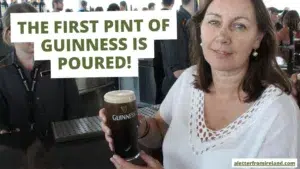
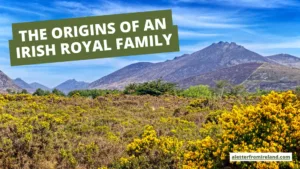
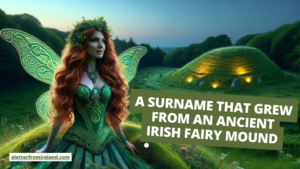
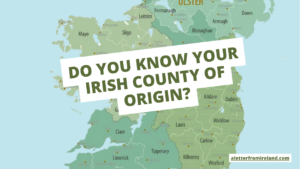
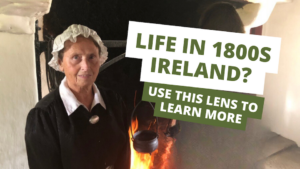
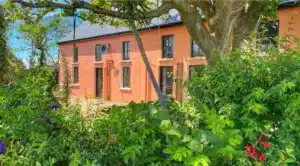
Only Plus Members can comment - Join Now
If you already have an account sign in here.